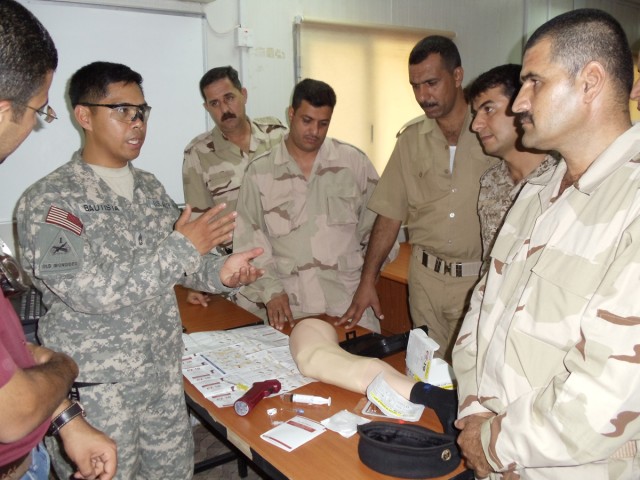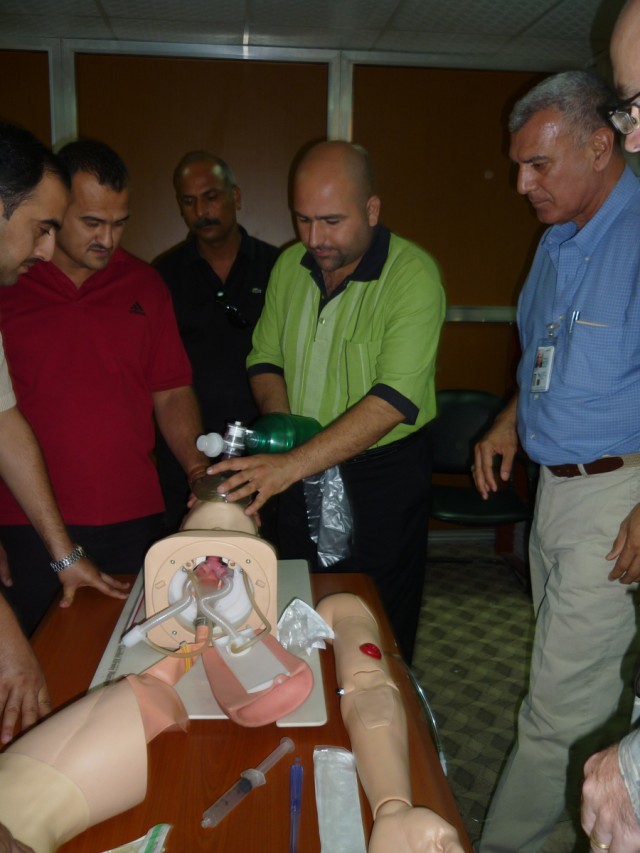BAGHDAD-First responders can often be the difference between life and death in an emergency situation. In dangerous environments like Iraqi Security Forces sometimes face in Iraq, the actions of first responders ensure those in need of medical treatment get it as quickly as possible.
A critical lifesaving skills course-organized and taught by personnel from a mobile training team with the Defense Institute for Medical Operations and the division surgeon's office with 1st Armored Division, United States Division-Center-was conducted for emergency medical personnel from the Baghdad area recently at a Ministry of Defense training facility in Baghdad.
Nineteen students from various medical backgrounds, including some in the Iraqi Security Forces, learned medical techniques that can be used to treat wounded people in a mass casualty scenario.
"DIMO is a unique mission of training international forces in health care," said Air Force Col. John T. Cinco, a flight surgeon and medical director for DIMO, and a Baltimore native. "The team of Soldiers and Airmen who conducted the five-day course, focused on basic emergency first aid techniques and actions taken as first responders.
"With this training, we hope to enhance their clinical skills so that they are able to save lives in the field and to leave them with information that can help them effectively operate during a mass casualty event," he said.
Lt. Col. Vincent Barnhart, division surgeon with 1st Armd. Div., and an Edenville, Pa., native, was invited to assist the DIMO in conducting this training. Having been in an emergency situation where he had to assist medical personnel on the scene, Barnhart knows firsthand how chaotic things can be.
"Being a first responder is a very difficult job," Barnhart said. "These guys have to sift through the distractions at the scene and make rapid assessments of those injured."
This particular course is designed to be a "train the trainer" course, meaning these students will take the skills learned during the training back to their home organizations to pass those skills on to fellow first responders.
"I was very impressed with the students' knowledge and enthusiasm about this training," Barnhart said. "There is a lot of stress that is associated with being a first responder. They have the responsibility of assessing a patient and figuring out what's going on in a very chaotic environment."
Asa'ad Tu'ma Salman, a biologist and instructor at the Military Medical Institute in Baghdad, said he plans to use this additional training to serve the Iraqi people better.
"If we implement this training, we will be able to minimize the number of casualties and properly treat them accordingly-civilian and military," he said.
Using life-like training aids, the students practiced administering intravenous injections directly into the bone using an Intravenous Infusion System, opening airways, controlling bleeding, reinflating a collapsed lung and applying tourniquets, which were just a few of the tasks learned during the hands-on portion of the course.
The hands-on techniques learned were only part of the course. Students also learned how to organize an emergency response and how to secure a site in that environment.
With their certificates of training, these medical professionals return to their units and organizations with an additional set of skills that could prove instrumental in teaching others how to save lives.
"Hopefully the training that they received was sustainable and will leave a lasting impression for years to come," Barnhart said.






Social Sharing